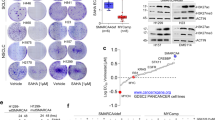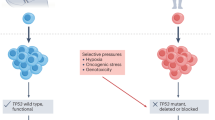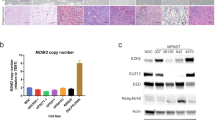Summary
p53 mutations are among the most common genetic alterations in human cancer and are frequently described in intrinsic or acquired radio- and chemotherapy resistance. Radiation-induced cell kill is not only mediated by DNA damage but also by the activation of signal transduction cascades generated at the plasma membrane like the sphingomyelin pathway. We used genetically defined wild-type p53 or p53-deficient mouse fibrosarcoma cells to investigate the p53-dependence of tumour response upon activation of the sphingomyelin pathway. Treatment of the tumour cells with neutral sphingomyelinase drastically reduced the amount of wild-type p53 fibrosarcoma cell proliferation over 72 h in a clear dose–response (0.2–1.0 U ml−1 nSMase). Sphingomyelinase had no effect on cell proliferation in tumour cells lacking p53. Similarly, cell proliferation was abolished by C2-ceramide (5–20 μM) only in wild-type p53 cells. FACS-analysis revealed that C2-ceramide induced massive p53-dependent apoptosis (40–50% after 12–24 h) and cell cycle analysis showed a transient G1 arrest in p53-deficient tumour cells 12–24 h after C2-ceramide exposure. These results suggest that ceramide-induced apoptosis in tumour cells can be dependent on the status of p53 and imply that p53 is also important for stress-induced apoptotic signal transduction cascades generated at the plasma membrane.
Similar content being viewed by others
Article PDF
Change history
16 November 2011
This paper was modified 12 months after initial publication to switch to Creative Commons licence terms, as noted at publication
References
Alesse, E., Zazzeroni, F., Angelucci, A., Giannini, G., Di Marcotullio, L. & Gulino, A. (1998). The growth arrest and downregulation of c-myc transcription induced by ceramide are related events dependent on p21 induction, Rb underphosphorylation and E2F sequestering. Cell Death Diff 5: 381–389.
Amarante-Mendes, G. P., Naekyung Kim, C., Liu, L., Huang, Y., Perkins, C. L., Green, D. R. & Bhalla, K. (1998). Bcr-abl exerts its antiapoptotic effect against diverse apoptotic stimuli through blockage of mitochondrial release of cytochrome C and activation of caspase-3. Blood 91: 1700–1705.
Chinnaiyan, A. M., Orth, K., O’Rourke, K., Duan, H., Poirier, G. G. & Dixit, V. M. (1996). Molecular ordering of the cell death pathway: Bcl-2 and Bcl-xL function upstream of the CED-3 like apoptotic proteases. J Biol Chem 271: 4573–4576.
Chmura, S. J., Nodzenski, E., Beckett, M. A., Kufe, D. W., Quintans, J. & Weichselbaum, R. R. (1997). Loss of ceramide production confers resistance to radiation-induced apoptosis. Cancer Res 57: 1270–1275.
Clarke, A. R., Purdie, C. A., Harrison, D. J., Morris, R. G., Bird, C. C., Hooper, M. L. & Wyllie, A. H. (1993). Thymocyte apoptosis induced by p53-dependent and independent pathways. Nature 362: 849–852.
Darzynkiewic, Z. (1995). In Cell Growth and Apoptosis, Sudzinski GP. Oxford University Press: Oxford
Datta, S. R., Dudek, H., Tao, X., Masters, S., Fu, H., Gotoh, Y. & Greenberg, M. E. (1997). Akt phosphorylation of BAD couples survival signals to the cell-intrinsic death machinery. Cell 91: 231–241.
Fisher, D. E. (1994). Apoptosis in cancer therapy: crossing the threshold. Cell 78: 539–542.
Haimovitz-Friedman, A., Kan, C. C., Ehleiter, D., Persaud, R. S., McLouglin, M., Fuks, Z. & Kolesnick, R. N. (1994). Ionizing radiation acts on cellular membranes to generate ceramide and induce apoptosis. J Exp Med 180: 525–535.
Haimovitz-Friedman, A., Kolesnick, R. N. & Fuks, Z. (1997). Ceramide signaling in apoptosis. Br Med Bull 53: 539–553.
Hannun, Y. A. & Linardic, C. M. (1993). Sphingolipid breakdown products: anti-proliferative and tumor-suppressor lipids. Biochim Biophys Acta 1154: 223–236.
Hannun, Y. H. (1997). Apoptosis and the dilemma of cancer chemotherapy. Blood 89: 1845–1853.
Harris, C. C. (1996). Structure and function of the p53 tumor suppressor gene: clues for rational cancer therapeutic strategies. J Natl Cancer Inst 88: 1442–1455.
Herr, I., Wilhelm, D., Böhler, T., Angel, P. & Debatin, K. M. (1997). Activation of CD95 (Apo-1/Fas) signaling by ceramide mediates cancer therapy-induced apoptosis. EMBO J 16: 6200–6208.
Jacks, T., Remington, L., Williams, B., Schmitt, E., Halachmi, S., Bronson, R. & Weinberg, R. (1994). Tumor spectrum analysis in p53-mutant mice. Curr Biol 4: 1–7.
Jarvis, W. D., Kolesnick, R. N., Fornari, F. A., Traylor, R. S., Gewirtz, D. A. & Grant, S. (1994). Induction of apoptotic DNA damage and cell death by activation of the sphingomyelin pathway. Proc Natl Acad Sci USA 91: 73–77.
Jarvis, W. D., Grant, S. & Kolesnick, R. N. (1996). Ceramide and the induction of apoptosis. Clin Cancer Res 2: 1–6.
Jayadev, S., Liu, B., Bielawska, A. E., Lee, J. Y., Nazaire, F., Pushkareva, M. Y., Obeid, L. M. & Hannun, Y. A. (1995). Role for ceramide in cell cycle arrest. J Biol Chem 270: 2047–2052.
Kinscherf, R., Claus, R., Wagner, M., Gehrke, C., Kamencic, H., Hou, D., Nauen, O., Schmiedt, W., Kovacs, G., Pill, J., Metz, J. & Deigner, H. P. (1998). Apoptosis caused by oxidized LDL is manganese superoxide dismutase and p53 dependent. FASEB J 12: 461–467.
Kuroki, J., Hirokawa, M., Kitabayashi, A., Lee, M., Horiuchi, T., Kawabata, Y. & Miura, A. B. (1996). Cell permeable ceramide inhibits the growth of B lymphoma Raji cells lacking TNF-alpha-receptors by inducing G0/G1 arrest but not apoptosis: a new model for dissecting cell-cycle arrest and apoptosis. Leukemia 10: 1950–1958.
Lowe, S. W., Schmitt, E. M., Smith, S. W., Osborne, B. A. & Jacks, T. (1993a). p53 is required for radiation-induced apoptosis in mouse thymocytes. Nature 362: 847–849.
Lowe, S. W., Ruley, H. E., Jacks, T. & Housman, D. E. (1993b). p53-dependent apoptosis modulates the cytotoxicity of anticancer agents. Cell 74: 957–967.
Lowe, S. W., Bodis, S., McClatchey, A., Remington, L., Ruley, H. E., Fisher, D. E., Housman, D. E. & Jacks, T. (1994a). p53 can determine the efficacy of cancer therapy in vivo. Science 266: 807–810.
Lowe, S. W., Jacks, T., Housman, D. E. & Ruley, H. E. (1994b). Abrogation of oncogene-associated apoptosis allows transformation of p53-deficient cells. Proc Natl Acad Sci USA 91: 2026–2030.
Maity, A., Kao, G. D., Mische, R. J. & McKenna, W. G. (1997). Potential molecular targets for manipulating the radiation response. Int J Radiat Oncol Biol Phys 37: 639–653.
Miyashita, T. & Reed, J. C. (1995). Tumor suppressor p53 is a direct transcriptional activator of the human bax gene. Cell 80: 293–299.
Obeid, L. N., Linardic, C. M., Karolak, L. A. & Hannun, Y. A. (1993). Programmed cell death induced by ceramide. Science 259: 1769–1771.
Ruley, H. E. (1996). In Important Advances in Oncology, DeVita VT, Hellmann S and Rosenberg SA (eds). Lippincott: Philadelphia
Santana, P., Pena, L. A., Haimovitz-Friedman, A., McLoughlin, M., Cordon-Carlo, C., Schuchman, E. H., Fuks, Z. & Kolesnick, R. (1996). Acid sphingomyelinase-deficient human lymphoblasts and mice are defective in radiation-induced apoptosis. Cell 86: 189–199.
Suzumiel, I. (1994). Review: Ionizing radiation-induced cell death. Int J Radiat Oncol Biol Phys 66: 329–341.
Tsuchida, E. & Urano, M. (1997). The effect of UCN-01 (7-hydroxystaurosporine), a potent inhibitor of protein kinase C, on fractionated radiotherapy or daily chemotherapy of a murine fibrosarcoma. Int J Radiat Oncol Biol Phys 39: 1153–1161.
Verheij, M., Bose, R., Lin, X. H., Yao, B., Jarvis, W. D., Grant, S., Birrer, M. J., Szabo, E., Zon, I., Kyriakis, J. M., Haimovitz-Friedman, A., Fuks, Z. & Kolesnick, R. N. (1996). Requirement for ceramide-initiated SAPK/JNK signalling in stress-induced apoptosis. Nature 380: 75–79.
Wyllie, A. H. (1993). Apoptosis (The Frank Rose Memorial Lecture). Br J Cancer 67: 205–208.
Zhou, H., Summers, S. A., Birnbaum, M. J. & Pittman, R. N. (1998). Inhibition of Akt kinase by cell-permeable ceramide and its implications for ceramide-induced apoptosis. J Biol Chem 27: 16568–16575.
Zundel, W. & Giaccia, A. (1998). Inhibition of the anti-apoptotic PI(3)K/Akt/Bad pathway by stress. Genes Dev 12: 1941–1946.
Author information
Authors and Affiliations
Rights and permissions
From twelve months after its original publication, this work is licensed under the Creative Commons Attribution-NonCommercial-Share Alike 3.0 Unported License. To view a copy of this license, visit http://creativecommons.org/licenses/by-nc-sa/3.0/
About this article
Cite this article
Pruschy, M., Resch, H., Shi, YQ. et al. Ceramide triggers p53-dependent apoptosis in genetically defined fibrosarcoma tumour cells. Br J Cancer 80, 693–698 (1999). https://doi.org/10.1038/sj.bjc.6690411
Received:
Revised:
Accepted:
Published:
Issue date:
DOI: https://doi.org/10.1038/sj.bjc.6690411
Keywords
This article is cited by
-
P53-dependent upregulation of neutral sphingomyelinase-2: role in doxorubicin-induced growth arrest
Cell Death & Disease (2015)
-
Tumor suppressive functions of ceramide: evidence and mechanisms
Apoptosis (2015)
-
Ceramide-orchestrated signalling in cancer cells
Nature Reviews Cancer (2013)
-
Defining a role for sphingosine kinase 1 in p53-dependent tumors
Oncogene (2012)



